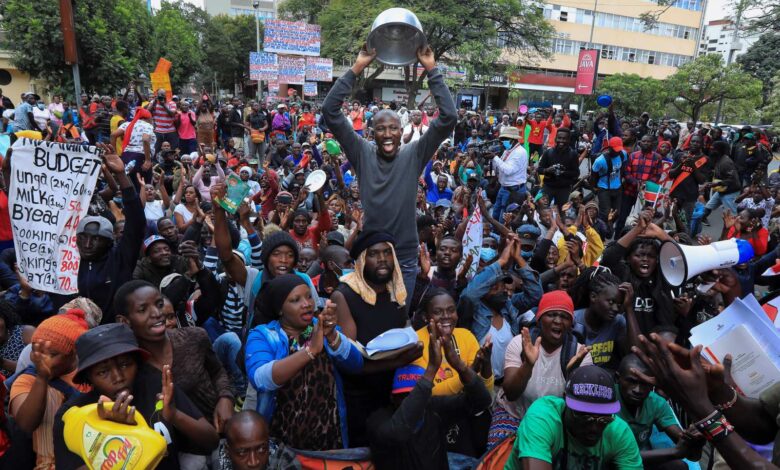
By Hippolyte Fofack
Special to The Times Kuwait
The rising cost of living in Africa has triggered a wave of protests in recent months, underscoring the disproportionately higher economic and social costs of inflation on a continent with persistent widespread poverty and heightened vulnerability to global volatility. The world, it seems, is now living through a tale of two inflations.
Initially, the current inflation cycle — a product of pandemic supply shocks and escalating geopolitical tensions — affected developed and developing countries alike. But inflationary pressures have become less synchronous over time. While price growth has fallen sharply in advanced economies, it remains stubbornly high, and, in some cases, rising, in Africa. And even though inflation in many developed countries is trending down to central banks’ 2 percent target, it has hit double digits in nearly one-third of African countries (a ratio that is even higher when excluding CFA franc countries, where the euro peg has contributed to monetary stability).
For example, the annualized inflation rate in Nigeria, one of Africa’s largest economies, hit 34 percent — a 28-year high — in May, and is forecast to remain elevated in the second half of the year, largely owing to soaring food inflation, which accelerated to 40 percent. This stands to reduce household purchasing power and raise the risk of food insecurity even more, especially for Nigeria’s growing rank of poverty-stricken and most vulnerable citizens. The country has the world’s largest population living in poverty after India. Meanwhile, government reforms to attract foreign investors — including the sharp devaluation of the naira, which has lost 70 percent of its value against the dollar since June 2023 — have only made matters worse for a country that relies heavily on imports of food and other essentials.
In August, protests against the resulting economic hardship spread across several large Nigerian cities. They followed weeks of riots in Kenya against the government’s finance bill, which proposed tax hikes on basic goods such as oil, bread, and sanitary pads, even as millions were already struggling to make ends meet. Dozens of demonstrators in both countries were killed during official attempts to quell the uprisings.
Food-price inflation affects low-income households more than their high-income counterparts because they spend a greater portion of their budget on necessities. Consider that food costs account for 16 percent of consumer spending in advanced economies, but around 40 percent in Sub-Saharan Africa (SSA). This difference in the composition of spending explains the more regressive nature of inflation in SSA, which is home to 60 percent of the world’s extreme poor, and why inflation there carries a greater risk of political upheaval.
The lack of formal employment opportunities has also exacerbated Africa’s cost-of-living crisis. To be sure, the wages of low-income workers with formal jobs are not keeping pace with price increases. But informal sector activities — a disguised form of unemployment and constraint on shared prosperity — account for roughly 85 percent of total employment on the continent, and these workers must also deal with income volatility and unexpected components of inflation, further tightening the squeeze on households.
Recent research assessing the distributional effects of the inflation cycle on households in the United States found a phenomenon known as ‘inflation inequality’: prices have risen more quickly for those at the bottom of the income distribution than for those at the top. The spread of protests across Africa suggests that a similar dynamic is at work on the continent, where the disproportionately higher food prices caused by positive exchange-rate pass-throughs have dramatically increased the welfare costs of this inflation cycle.
Government policies have also heightened the cost-of-living crisis. Instead of supporting vulnerable groups through targeted interventions, African governments have indiscriminately raised taxes and cut spending to meet external liabilities. Interest payments on sovereign debt now consume around one-third of Kenya’s revenue and more than two-thirds of Nigeria’s. In both countries, procyclical fiscal policy and austerity measures have had a knock-on effect on prices, stoking inflation and worsening the cost-of-living crisis.
But in response to the protests, governments are reversing some of their procyclical policies or implementing complementary measures to mitigate their impact. Kenyan President William Ruto dismissed his entire cabinet and withdrew the controversial finance bill, which was expected to raise $2.7 billion in additional revenue to meet fiscal targets set by the International Monetary Fund. In Nigeria, the government has announced a 150-day suspension of import duties for certain foods to alleviate the pressure on struggling households.
Nonetheless, more must be done to close the gap between actual and potential growth and expand opportunities for young people. Africa is the world’s most natural-resource-rich continent, yet Africans face bleak futures in countries that lack sufficient engineers and political will to transform these resources, create enough well-paying jobs, and expand prosperity. Africa’s excessive reliance on imports as an alternative to expanding aggregate output has sustained external imbalances and hollowed out the jobs market, causing more people to fall into destitution.
To meet the aspirations of young populations, African governments should rethink constraints on public spending and overcome the recurrent balance-of-payments crises that have long shaped economic policy across the continent. Increased investment in building a workforce that is fluent in emerging technologies is critical to spurring industrialization. This, in turn, would bolster Africa’s manufacturing sector, which in other parts of the world has long served as a social escalator and growth accelerator, catalyzing convergence with high-income countries. The transformation of African economies will also drive the development of regional value chains, bolster intra-African trade (and thus mitigate the region’s exposure to global volatility), and build large national buffers to wean the region off debilitating aid dependency.
Africa’s policymakers must not only invest in human capital to move their countries up the value ladder in a global economy where technology has become a key driver of growth. They must also strive to equalize access to opportunities and achieve shared prosperity to strengthen the concept of the nation-state and enhance national security. To quote Samora Machel, the first president of Mozambique, “For the nation to live, the tribe must die.” For too long, a tribal approach to governance has undermined national development, perpetuating intergenerational poverty and exacerbating inflation inequality.

Hippolyte Fofack
A former chief economist and director of research at the African Export-Import Bank, is a Parker fellow with the SDSN at Columbia University, a research associate at the Harvard University Center for African Studies, a distinguished fellow at the Global Federation of Competitiveness Councils, and a fellow at the African Academy of Sciences.
Copyright: Project Syndicate, 2024.
www.project-syndicate.org












